|
|
18 luglio, 2011 

Da Primorski Dnevnik, 4.luglio.2011
Share on Facebook
12 luglio, 2011
I Vini Di Edi Keber A Zegla (go)
di Giuditta Lagonigro.
Edi Keber, viticoltore di Zegla, località del Collio a pochi metri dalla Brda slovena, è uno dei massimi esponenti di questo territorio; l’eccellente qualità dei suoi vini corre in parallelo con la vivacità del carattere vulcanico di questo contadino (tale si definisce), fucina di sempre nuove idee per la valorizzazione della sua terra, portatore sano di un grande entusiasmo con cui coinvolge tutti gli amici, produttori e non.
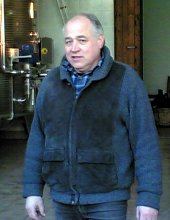 Edi Keber, in vigna, ha continuato il lavoro dei suoi genitori e dei suoi zii, con la stessa passione ed un grande amore per la vita semplice, a stretto contatto con la Natura, non mancando anche di allargare le sue iniziative alla promozione di manifestazioni culturali (ultima una mostra di quadri, itinerante per “cantine”…). Splendida la sua famiglia, Silvana, paziente e fidata consorte, la piccola Veronika ed il giovane Kristian, erede già autorevole. Proprio a Kristian chiediamo di parlarci dell’azienda. Edi Keber, in vigna, ha continuato il lavoro dei suoi genitori e dei suoi zii, con la stessa passione ed un grande amore per la vita semplice, a stretto contatto con la Natura, non mancando anche di allargare le sue iniziative alla promozione di manifestazioni culturali (ultima una mostra di quadri, itinerante per “cantine”…). Splendida la sua famiglia, Silvana, paziente e fidata consorte, la piccola Veronika ed il giovane Kristian, erede già autorevole. Proprio a Kristian chiediamo di parlarci dell’azienda.
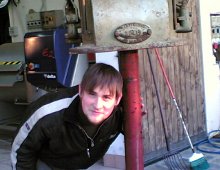
Kristian Keber: L’azienda si estende su 10 ettari di vigneto, tutti in località Zegla, con un’ottimale esposizione verso sud.
Giuditta: qualche informazione sui vigneti.
Kristian Keber: Il sistema di allevamento delle viti è del tipo Guyot, con una produzione di circa 1-1,5 kg per pianta e con una densità di impianto di 5000 ceppi per ettaro.
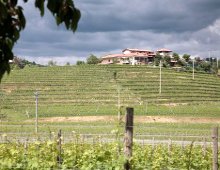
Giuditta: come vinificate?
Kristian Keber: La raccolta delle uve è rigorosamente manuale. La vinificazione è di tipo tradizionale. L’uva raccolta viene pressata a grappolo intero per preservare le ossidazioni in pigiatura, di seguito il mosto viene chiarificato e posto nelle celle in cemento dove avviene la fermentazione. In tali contenitori il vino si affina per 5 mesi. Una percentuale del 20% viene pure lavorata in contenitori di rovere da 4 ettolitri.
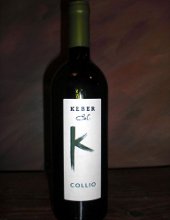
Giuditta: Il vostro prodotto di punta è stato, fino allo scorso anno, il Tocai (oggi Friulano), grande vino con un intrinseco ed inconfondibile gusto… Keber. Però, con dispiacere dei tanti estimatori, nel 2008 avete fatto una scelta radicale. Raccontaci cos’è successo.
Kristian Keber: L’annata 2008 ha segnato un traguardo epocale per la storia della nostra azienda in quanto dai due vini bianchi prodotti, cioè il Tocai Friulano ed il Collio (da uve Tocai, Ribolla, Malvasia, Pinot), siamo passati alla produzione di un unico vino a bacca bianca, cioè il Collio, composto essenzialmente da uve Tocai Friulano. Questa varietà assume un’eccellente qualità proprio nella zona cormonese; coltivata sulla “ponka” (flysh) -la ponka è un tipo di terreno composto da marna e arenaria-, da’ vita ad un vino molto struttutato e di buona grassezza. Il 90% della produzione sarà destinato a questo nuovo ed importante vino, il Collio, per l’appunto. Con tale progetto crediamo di dare ancora più prestigio a tale vino e al territorio stesso.Oltre a ciò vogliamo semplificare la scelta al consumatore che, quando chiederà un “Keber” saprà di bere un Collio da base uve Tocai Friulano.
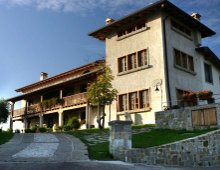
Ringrazio Kristian ed aggiungo che di grande interesse è la versione non filtrata del Collio Bianco-prodotto da vecchi vigneti di Ribolla gialla, Malvasia e Tocai Friulano-; il vino viene mantenuto sui suoi lieviti naturali e messo in bottiglia senza essere filtrato. Non meravigliatevi quando sull’etichetta leggerete: Agitare prima dell’uso! Il movimento servirà a mettere in circolo tutte le particelle vitali presenti nella bottiglia, rigorosamente una magnum… Per gli appassionati di vino rosso aggiungiamo che l’Azienda Keber ha una limitata produzione di Collio Rosso, da uve Merlot e Cabernet Franc, vinificato e maturato in legno per sei mesi. I Keber danno anche ospitalità, attraverso un B&B; le stanze sono con vista sul Collio e Silvana non fa mancare le leccornìe dolci e salate per una prima colazione robusta, necessaria per procedere con le ossigenanti passeggiate lungo i vigneti…
L’indirizzo della cantina di Keber Edi è
Località Zegla,17
34071 Cormons (Go)
tel/fax 0481 61 184
mail: edikeber@tin.it
Share on Facebook
11 luglio, 2011 

 Dal mensile DEGUSTA, giugno 2011 Dal mensile DEGUSTA, giugno 2011
www.degusta.it
Share on Facebook
8 luglio, 2011
Cliccando sul link trovate la versione scaricabile in PDF della rivista GIRO ESTATE 2011 dove c’e anche un bellissimo articolo sul Collio!






Giro – anno VII – nr. 2 – edizione estate 2011
Share on Facebook
6 luglio, 2011 
Martino Turista Per Collio
Il reportage di Giuditta
di Giuditta Lagonigro.
Il Collio – zona collinare che si estende dalla provincia di Gorizia fino alla Slovenia (Brda) - invita, specialmente nella bella stagione, a rilassanti passeggiate tra vigneti e boschi.

Ma c’è un’alternativa più frizzante, più vivace, più sprint: un bel giro in vespa!
E’ la splendida idea che qualche anno fa è stata adottata per permettere ai visitatori di guardare il Collio con due “ruote” diverse!
La vespa, rigorosamente gialla, è diventata il simbolo del territorio. Oggi se ne contano una trentina, presenti nelle aziende della zona, messe a disposizione di turisti che vogliano provare un’emozione diversa e spostarsi senza troppe difficoltà.

Poteva, il nostro Direttore, Martino Ragusa, turista per definizione e vocazione, non approfittare della sua visita a Cormons per provare l’ebbrezza dell’aria primaverile, respirata a pieni polmoni sulla vespa?
In tutta sincerità di brezza primaverile non c’era traccia; le condizioni meteorologiche non sono state clementi ma ci hanno almeno consentito di scorrazzare per due ore lungo un percorso predisposto dalle nostre guide.
Ma andiamo per ordine..

Martino arriva il 15 pomeriggio a Monfalcone, un caffè e subito in auto, verso la nostra meta.
La prima tappa è l’Agriturismo in cui Martino pernotterà: Borg da Ocis, a Borgnano, frazione di Cormons.
Borg de Ocis, gestito dalla famiglia Zoff, ha come attività principale l’allevamento di bovini  (Pezzata Rossa) per la produzione di carne e formaggi. Gli animali hanno uno spazio a cielo aperto, oltre alla stalla. (Pezzata Rossa) per la produzione di carne e formaggi. Gli animali hanno uno spazio a cielo aperto, oltre alla stalla.
Giuseppe Zoff, continuando il lavoro di Alfredo e Matilde, che hanno avviato l’azienda, si occupa dell’attività agricola, animali e produzione del loro fabbisogno alimentare.
Con la collaborazione di

Patrizia, sua moglie, trasforma nel piccolo caseificio di famiglia il latte in formaggi di qualità, utilizzando tecniche di vecchi casari che non alterano il gusto del prodotto finale.
Le figlie, Laura ed Aurora, si occupano dell’accoglienza degli ospiti.
Cinque sono le stanze, in severo stile contadino, adatte ad ore di assoluto riposo, che portano ciascuna il nome di una bovina che per vari motivi è rimasta nel cuore della famiglia Zoff.

Per inciso Martino ha alloggiato nella stanza blu, dedicata ad Axa.
La prima colazione (unico pasto servito a Borg de Ocis), prevede le specialità di casa: ricotta e formaggi freschi, yogurt, marmellate, fragranti e profumate torte.
Martino ha solo il tempo di rinfrescarsi e fare una breve chiacchierata con i gentilissimi padroni di casa.
Io, nel mio ruolo di driver, devo scandire il tempo.

Si va a Cormons, dove, in Piazza XXIV Maggio, davanti all’Enoteca, ci aspetta una piccola squadra di “vespisti”.
Kristian Keber, Mitja Juretic, Ivan Fabiani, capeggiati dalla ineguagliabile Elena Orzan, hanno scaldato i motori.
Infiliamo il casco e via! Bisogna approfittare di qualche raggio di sole che il cielo generosamente irradia. L’avventura comincia.
Si va alla scoperta dei tesori del Collio!
Non ci aspettiamo monili o denaro ma prodotti della terra di prima qualità..
Eccoci accontentati.

La prima tappa prevede una sosta a casa di Piero Calligaris, coltivatore dell’asparago bianco del Friuli Venezia Giulia.
In bella vista alcuni esemplari dell’ottimo ortaggio, quest’anno penalizzato dalla eccessiva pioggia: non si è raggiunto il peso di g 250 per esemplare, come di solito come accade nelle ottime annate.

Assaggiamo gli asparagi crudi, sono dolcissimi, croccanti e tenerissimi. Purtroppo la produzione è limitata.
Gli asparagi possono essere consumati in mille varianti: crudi in insalata, nei classici risotti e pasticci, alla piastra, conditi con un filo di olio evo.
La nostra chiacchierata si conclude con una fetta di ottimo salame locale ed un brindisi con uno spumante prodotto dalla Cantina Produttori di Cormons.

Una leggera pioggia ci induce a risalire sulle vespe ed a riprendere il giro, prima che diluvi.
Elena ci fa strada: stiamo andando a visitare il “macello” di Cormons, che, dopo anni di inattività, è stato ristrutturato e poi preso in gestione da privati;  sarebbe opportuno che gli organi competenti riuscissero a completare la struttura in modo da creare una filiera corta per la trasformazione delle carni lavorate. sarebbe opportuno che gli organi competenti riuscissero a completare la struttura in modo da creare una filiera corta per la trasformazione delle carni lavorate.
Sono questioni politiche, noi possiamo solo accennarle auspicando, per la qualità del nostro cibo e quindi per la nostra salute, che le Istituzioni rivolgano la loro attenzione anche a tali richieste.
Ma andiamo avanti!

Il rombo delle quattro vespe rompe, con discrezione, il silenzio e la tranquillità delle colline.
Poi siamo stati invitati ad una festa, l’inaugurazione dell’Agriturismo “Al Confine”, a Plessiva (www.al-confine.it/ info@al-confine.it)!
Assistiamo al discorso di saluto del sindaco di Cormons ed alla benedizione del Parroco, con successivo taglio del nastro… Auguri per la nuova attività!
Accogliamo volentieri l’invito ad assaggiare le leccornie preparate per l’evento: salami, prosciutto, cotechino alla piastra, fragrante pane di casa, dolci tipicamente sloveni. Siamo praticamente sul confine con la Brda Slovena. Ci rifocilliamo volentieri perché la temperatura si è notevolmente abbassata.
Peccato, dobbiamo abbandonare le vespe e tornare a Cormons in auto. Da un evento all’altro.

E’ in corso un appuntamento di “In Vino Veritas”, manifestazione organizzata dall’Enoteca di Cormons, ogni sabato nei mesi di maggio e giugno, durante la quale si possono degustare gratuitamente i vini dei Produttori, soci della stessa Enoteca.
La serata, come sempre, ha attirato numerosi eno-appassionati che seguono i racconti dei produttori presenti e le interessanti, informali, lezioni di degustazione di vini.
Non ci sottraiamo a questo nuovo invito e ascoltiamo con attenzione, bevendo anche un calice di ottima malvasia.

Non è tardi e, anche se stanchi, decidiamo di andare a trovare un grande produttore di vino bianco, oltre che grande e sempre disponibile amico, Edi Keber.
Edi e Silvana Keber ci accolgono con la consueta gentilezza (il loro figlio Kristian è stato il mio conduttore durante il giro in vespa).

E’ d’obbligo un calice di Collio Bianco, reso ancora più gradevole dal tepore del camino che Edi ha acceso, nonostante la primavera inoltrata.
La serata si conclude con una bella e distensiva chiacchierata, l’appuntamento è per l’indomani.

Martino, finalmente riposatosi e ritempratosi nell’accogliente dimora di Borg da Ocis, è pronto per un altro appuntamento in Enoteca: la presentazione del suo libro “Il Manifesto della Cucina Nazionale Italiana”.

C’è un pubblico molto interessato, che conosce il “Martino scrittore” ed il “Martino Turista”. Abbiamo anche avuto il piacere della presenza di Josko Sirk, produttore dell’Aceto del Collio, come lo ha ribattezzato Martino in una ricetta del libro. Nell’occasione è stato offerto ai presenti un assaggio di Sorbetto all’aceto, interessante ricetta che prevede l’aceto quale insolito ingrediente del particolare gelato.

La discussione sul nuovo progetto verso una cucina prettamente italiana si anima; il confronto è stimolante e chiarificatore di alcuni aspetti del “ragusano” pensiero, innovativo e, per certi versi, trasgressivo. Naturalmente ed in conclusione, l’invito a partecipare alle future attività della Compagnia del Cibo Sincero di cui vengono illustrate le finalità. Non può mancare il brindisi di saluto che, in effetti, è solo un aperitivo.

Non vogliamo far ripartire il nostro ospite a stomaco vuoto ed allora si va in Subidina, una deliziosa Osteria, a qualche chilometro da Cormons in cui Stefano, lo chef, propone piatti della tradizione rivisitati con gusto ed innovazione.
Il tempo a nostra disposizione è davvero agli sgoccioli e ci rechiamo in stazione.
Martino intraprende un nuovo viaggio di ritorno, ripercorrendo l’Italia intera: in poche ore dalle Alpi all’Etna, una magia che speriamo si ripeta, tra qualche tempo, per un altro interessante e piacevole incontro.
Grazie Martino, alla prossima!
A Voi, gentili Lettori e potenziali Turisti per Collio, l’invito a raggiungere le amene località, solo in minima parte descritte.
In vespa, in bici, a piedi o con qualunque altro mezzo, potrete trascorrere ore spensierate, sorseggiando, con prudenza, ottimo vino e gustando cibi genuini, in buona e sincera Compagnia!
Share on Facebook
4 luglio, 2011 In Italy, Vineyards by Vespa

Dave Yoder for The New York Times
The author on the Vespa she rode through the Collio wine district of northeastern Italy, where she tasted some of the region’s best whites along the way.
By INGRID K. WILLIAMS
“IS it normal for the carabinieri to be drinking at noon?” I asked, gesturing toward five members of the Italian military police swirling and sipping glasses of white wine.
Dave Yoder for The New York Times
“No,” said the bespectacled, curly-haired man standing next to me at the Enoteca di Cormòns, with a chuckle. “But it’s Friulano,” he said, referring to the local varietal, “so it’s O.K.” A sly smile widened beneath his gray mustache as he clinked his glass against mine.
My husband, Dave, and I had just arrived in Collio, a sleepy wine region in northeastern Italy defined by crisp white wines that are among the country’s best. Hugging the border with Slovenia, Collio has a curious culture that leans more Mitteleuropa than Mediterranean, but the ideal way to taste the terroir-rich whites produced in these bucolic hills is still unmistakably Italian: cruising between rural vineyards on the iconic vehicle of Italian daydreams, the Vespa.
Marrying wine tastings with Vespas may seem foolhardy at first. However, with a few sensible precautions (alternating driving duties with a companion, taking leisurely vineyard tours after each tasting, spitting), it’s an unexpectedly fun union that captures the same carefree spirit that Dave and I first encountered at the enoteca, without veering into irresponsibility.
The seed of Collio’s vino-and-Vespa idea can be traced to one historic night in late 2007 and two friends, Edi Keber, a vintner, and Josko Sirk, a vinegar producer and owner of La Subida, an area inn with a Michelin-starred restaurant. “On the day when the border was removed and Slovenia officially entered the E.U., Edi and I took two Vespas,” Mr. Sirk told me, recounting the story of the joyful celebration. “All night long, we drove back and forth across the border.”
That jubilation has since blossomed into the “Collio in Vespa” program, in which about 70 Vespas, all painted a sunny hue, are now available for tourists who want to zip between tours and tastings.
So for four days in May, Dave and I did just that, landing a clutch of new friends along the way.
1. Ready, Set…
We planned to spend our first two nights at La Subida, a hotel in the hills, where, with the exchange of a key, we became the proud new custodians of one canary yellow 125-cubic-centimeter Vespa made for two. Since I had more experience driving a Vespa (four days to Dave’s one), I hopped in front first. But riding a Vespa is not like riding a bike; you can forget how.
To the evident amusement of a man sitting on a nearby bench, it took me an embarrassingly long time to recall how to start the engine (oh, right, apply the brake), and once started, how to accelerate (rotate the handlebar backward, not forward!). But then we were off, swerving onto the road and into a frolicking, unforgettable adventure that neither of us saw coming.
2. Enoteca di Cormòns: Ugo and His Many Friends
Our first stop was the Enoteca di Cormòns on the main piazza in the town of Cormòns, the very heart of Collio.
Cormòns is the sort of small, tight-knit place where describing someone as “Ugo with the glasses” is met with nodding recognition. The Ugo in question was our bespectacled new friend (and the local optician), who, after the carabinieri had departed, quickly introduced us to his friends, each of whom was a full generation older than we were. I have lived in Italy for nearly four years, but never before have I been so warmly embraced by strangers.
Within 20 minutes, though Dave and I were still nursing our first glasses of crisp Friulano, Ugo had bought us another round, and his friend Giovanni had escorted us outside to meet a visiting member of the Italian Parliament. Before we had even finished our platter of local Montasio cheese and hand-sliced prosciutto, Giovanni was inviting us to a private party later that night.
Literally marking an “X” at the location on our map, he told us, “Just say you’re friends of Giovanni’s.” Because, of course, we now were.
3. Edi Keber Winery: Hurdle in the Hills
The genius of touring Collio by Vespa is that there are dozens of vineyards scattered through the hills and not much traffic. Most wineries are family-run, and with a little notice, open to the public. Even in high season, tractors are more common than tour buses, and visitors can pop into almost any vineyard and taste rare vintages with the vintners themselves.
With Dave driving, we zoomed out of Cormòns along peaceful pastoral roads and up and over vine-draped hills. We had booked a tour and tasting at Edi Keber, a small winery known for producing mineral-rich white wine from a blend of Collio-grown Friulano, malvasia istriana and ribolla gialla varieties. As we neared our destination, a verdant patchwork of vineyards unfolded across the valley like a quilt; Slovenia’s stone farmhouses were just a grape’s throw away.
But then: near disaster. Turning the Vespa — perhaps a hair too fast — into the driveway, we skidded on the loose gravel and toppled to the ground, the scooter pinning my leg under the still-running and gravel-spewing machine. We clawed our way out from under the scooter, and once upright again, surveyed the damage: bruising to Dave’s pride, a scratched windshield on the Vespa and, for me, a greenish-purple right calf.
Composing ourselves, we joined Mr. Keber’s charming son Kristian in a restorative wine tasting. Since 2008, the winery has produced only one wine each year: a crisp, subtly floral white that is called, simply, “Collio.”
4. Outside Cormòns: Marino’s House
Having recovered from our afternoon scare, we made our way to the party heading up a driveway toward a grill billowing smoke, unsure we were at the right place. We arrived in an open, brightly lighted garage, where nearly two dozen people were gathered around a long table strewn with bottles of wine. Scanning the crowd in search of a familiar face, I had the sinking sensation that we were crashing a stranger’s dinner party when — there! — I spotted Giovanni.
A swirl of introductions ensued, and we were quickly plied with dripping skewers of goat meat pulled right off the grill. Soon the host of the party bounded over. Jovial and stout, with a bushy snow-white beard, Marino was Santa in the flesh.
“Come, sit, eat, drink!”
Creedence Clearwater Revival blared from speakers as we were shepherded to the table. There, the procession of food began: more meat skewers, bread, ostrich-egg frittata, homemade apple strudel.
Someone poured some Magnás sauvignon in my glass. “You know Magnás?” the pourer asked. When I shook my head no, I was presented to the vintner, Luciano Visintin, who gave me a wink from across the table.
It was inching toward midnight when the crowd began to thin. But by then, Carmelo, an animated Sicilian in head-to-toe denim and a thick, gray mustache, had already concocted more plans. “In Collio, mangiare, bere e basta,” he said: eat, drink and that’s it. So the next day at noon, the party would continue.
5. Magnás: Resuming the Feast
A screwball cast of nine rolled out of the enoteca the following day at lunchtime — among them, Carmelo, Marino, Giovanni, along with a retired Italian Air Force general and a white-haired man referred to simply as Il Presidente.
The local Collio cuisine has heavy Slavic and Austro-Hungarian influences, so meats and potato dumplings are more common than pasta and pizza, as we learned during our first stop, a rustic trattoria run by a local butcher, Sandro Seculin. Wine, then grappa, flowed freely around the table before the motley platoon retreated to Luciano’s winery, minutes down the road.
Once there, Marino insisted on giving me a tour of the property, showing off the stainless steel vats, the chicken coop and the pen with newborn bunnies. When we rejoined the group lounging on a terrace, Luciano was preparing an impromptu tasting. Vintners here grow many varieties and employ a wide range of techniques in the winemaking process, but the resulting wines are often surprisingly similar, with differences measured in subtle gradations of floral notes and hints of fruit.
When we eventually had to bid our new friends farewell — another tour, at the Dario Raccaro vineyard, awaited — we were rebuffed. “We’ll see you later,” Marino insisted knowingly, brushing my cheeks with his beard as he kissed me goodbye.
6. Castello di Spessa: Out of Gas
After two nights at La Subida, we decamped for our final two nights to Castello di Spessa, a creaky, apricot-colored castle at the end of a trellised path. It resides above a rolling 18-hole golf course framed by vineyards.
Winding along Collio’s tranquil back roads, I glanced at the gas gauge to see a fierce orange light blinking with great urgency, likely a Morse code for “Get thee to a gas station!”
Finding ourselves surrounded by indistinguishable rows of vines, Dave consulted the map, the sun, then the map again. Where were the gas stations hiding? Meanwhile, the menacing light seemed to blink more brightly around each bend. The engine hesitated when we merged onto a main road, but our beacon — an IP gas station sign — soon appeared. As the pumps finally came into view, the engine sputtered, and I heard Dave shout, “Lean forward!”
7. Gravner: Jug Wine
There’s no sign outside the Gravner winery, just a gravel driveway littered with giant terra-cotta jars, or amphorae.
“Amphora for wine is like amplification for music,” said Josko Gravner, the lanky vintner who, with his devoted dog Bruno trailing at his heels, had led us down into a dimly lighted cellar to show us his unconventional winemaking process, in which fermentation occurs over several months in amphorae buried to their top rims.
As he held a glass of sauvignon up to a light, the white wine appeared cloudy and undeniably orange. “You have to drink it to understand it,” he said. So I did.
8. Gorizia: Taking a Break From the Wine Trail
To assuage the guilt of doing little more than riding around on a Vespa and tasting wine for four days, we decided to visit the Oslavia military memorial, commemorating soldiers killed in World War I, and from there make our way to the town of Gorizia and its castle. The memorial was stark and moving, and the turquoise Isonzo River that cuts through Gorizia is lovely, but the castle, except for a few creepy faceless mannequins, was a bore. There was, however, a memorable lunch at Alla Luna, a restaurant cluttered with doilies, lace, dried flowers, keys and overstuffed pillows. We ordered fried potato-and-cheese crisps called frico; “Mitteleuropa gnocchi” drowning in butter, sugar and cinnamon; and “Slovenian gnocchetti” in a brown, meaty gravy that the menu described as “not nice to look at, but delicious to eat.”
My palate had not yet adapted to the heavy local cuisine, so we skipped dessert and bolted back across the river and into the quiet hills of Collio.
9. Venica & Venica: Different Concepts, One Idea
Following a tasting at Venica & Venica, we ran into Giampaolo Venica, the vineyard’s export manager, who, though still dressed in bicycle gear after a long ride, immediately offered to give us a tour. From a nearby hilltop, he pointed out the various plots of the vineyard, which was started by his grandfather and is now run by his father, Gianni, and uncle, Giorgio. “Collio is funny,” he said. “It’s one idea, but completely different ways to achieve it.”
It was true. We had visited Kristian Keber, who believes in making just a single kind of wine (“to promote the area and not a variety”); Venica & Venica, which produces 13 different varietals; Josko Gravner, who uses amphorae; and Raccaro, another small producer, where the wine passes through stainless steel vats.
Different beliefs and different methods, but award-winning results for all; in 2010, wines produced by each of those four vineyards earned the highest “tre bicchieri” rating from Gambero Rosso, the premier food and wine magazine in Italy. (In total, 15 Collio-designated whites earned the top rating last year.)
10. Back to Cormòns: Goodbye
For our last evening in Collio, Dave and I returned to Cormòns. Between a wine-tasting event at the enoteca and dinner at Al Giardinetto — the one restaurant that was recommended by everyone we asked — we took a short stroll through town. Around the corner from the main piazza, a familiar face popped out of a doorway: Ugo, the catalyst for our entire adventure. And when Dave and I circled back to the enoteca for a final glass of wine after dinner, we got a full-fledged reunion.
Kristian Keber was sitting outside with a group of friends. From inside, Elena the manager waved. Kristian soon followed us in, slipping behind the bar for glasses and insisting that we taste the bottle he had just bought for his friends. Back out on the piazza, one of the men from Marino’s surreal party stopped by our table to say hello, and before long, Marino himself appeared. Enveloping us in bear-paw handshakes and bushy-beard kisses, he finally bade us farewell. And with a rosy-cheeked smile, he bounded off into the Collio twilight.
If You Plan to Visit Collio, and Its Paths and Vineyards
In Collio, many inns, hotels and wineries have Vespas that guests may use for no additional charge. Vespas can also be rented in Cormòns at Azienda Zorgniotti (Via Vino della Pace, 18; 39-0481-60595) for 50 euros, or about $70 at $1.42 to the euro, a day.
WHERE TO STAY
La Subida (Via Subida, 52, Cormòns; 39-0481-60531; lasubida.it) is a complex of country cottages with a pool, playground and outdoor foosball table. The Michelin-starred restaurant Trattoria Al Cacciatore della Subida is a short walk away. High-season rates start at 110 euros a night.
Castello di Spessa (Via Spessa, 1, Capriva del Friuli; 39-0481-808124; castellodispessa.it) is a grand hotel in a castle that dates back to the 13th century, with rambling grounds, an 18-hole golf course and an elegant restaurant. Doubles cost 180 euros a night.
Many of the wineries we visited also offer guest rooms to visitors who prefer to sleep close to the vines. One that also has Vespas is Edi Keber, where rooms cost 90 euros a night.
WHERE TO TASTE
At Collio’s small family vineyards, it’s wise to call in advance to arrange tastings. Edi Keber (Località Zegla, 17, Cormòns; 39-0481-61184). Magnás (Via Corona, 47, Cormòns; 39-0481-60991; magnas.it). Gravner (Località Lenzuolo Bianco, 9, Oslavia; 39-0481-30882; gravner.it).Venica & Venica (Località Cerò, 8, Dolegna del Collio; 39-0481-61264; venica.it). Dario Raccaro (Via San Giovanni, 87, Cormòns; 39-0481-61425) is a small winery with a big reputation: three years ago (2008), their 2006 Tocai Friulano was named the best white wine in Italy by Gambero Rosso, the country’s premier food and wine magazine.
WHERE TO EAT
Enoteca di Cormòns (Piazza XXIV Maggio, 21, Cormòns; 39-0481-630371; enoteca-cormons.it). Agriturismo Seculin (Località Monticello, 2, Cormòns; 39-334-345-5285; aziendaagricolaseculin.com). Alla Luna (Via Guglielmo Oberdan, 13, Gorizia; 39-0481-530374). Al Giardinetto (Via Giacomo Matteotti, 54, Cormòns; 39-0481-60257). D’Osvaldo (Via Dante, 40, Cormòns; 39-0481-61644; dosvaldo.it) is a local producer of artisanal meats famed for its smoked prosciutto, a Cormòns specialty. Call ahead for a tour and tasting.
Dal sito di NEW YORK TIMES – Travel
Share on Facebook
1 luglio, 2011 AGRISTORIE : storie di Vite e di Vini
Azienda Edi Keber
Ho il piacere, a nome dell’Associazione Culturale l’Alfiere, di invitarvi, Sabato 2 Luglio, alle ore 18.00, all’ appuntamento annuale di Agristorie.
Andremo alla riscoperta delle storie di successo imprenditoriale di coloro che hanno valorizzato i prodotti della nostra Terra, attraverso la creazione di Aziende che salvaguardano le tradizioni locali, il Territorio e le sue tipicità, sapendosi comunque confrontare con l’innovazione e la creatività.
Obiettivo è aprire le porte della natura e della nostra storia locale regionale per contribuire al marketing territoriale ed al turismo consapevole.
Saremo Ospiti dell’Azienda Edi Keber
https://www.terredibeba.it/
Programma:
Ore 18.00 ritrovo press l’Azienda Edi Keber – Loc. Zegla, 17, 34071, Cormons GO
(richiesta per motivi organizzativi la puntualità)
Visita in cantina ed alla mostra d’arte collegata
Degustazione delle eccellenze prodotte
Vi aspettiamo!
Share on Facebook
29 giugno, 2011 Beba dapertutto! Ha trovato il suo posto anche sui cartoni di Aceto Sirk.

Share on Facebook
28 giugno, 2011 È veramente bello vedere Piccolo Collio in città!
La simpatia che il signor Bernot ha voluto riservare a Collio in Vespa e a Piccolo Collio, e il conseguente allestimento del negozio in Corso Verdi a Gorizia sono una cosa che ci lusinga.



Share on Facebook
27 giugno, 2011 L’ 11 e il 12.giugno si e svolta a Gorizia la 4° edizione di Let’s GO triathlon ad accompagnarli c’erano le nostre Vespe!


Share on Facebook
|
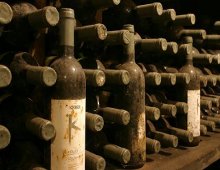
 Edi Keber, in vigna, ha continuato il lavoro dei suoi genitori e dei suoi zii, con la stessa passione ed un grande amore per la vita semplice, a stretto contatto con la Natura, non mancando anche di allargare le sue iniziative alla promozione di manifestazioni culturali (ultima una mostra di quadri, itinerante per “cantine”…). Splendida la sua famiglia, Silvana, paziente e fidata consorte, la piccola Veronika ed il giovane Kristian, erede già autorevole. Proprio a Kristian chiediamo di parlarci dell’azienda.
Edi Keber, in vigna, ha continuato il lavoro dei suoi genitori e dei suoi zii, con la stessa passione ed un grande amore per la vita semplice, a stretto contatto con la Natura, non mancando anche di allargare le sue iniziative alla promozione di manifestazioni culturali (ultima una mostra di quadri, itinerante per “cantine”…). Splendida la sua famiglia, Silvana, paziente e fidata consorte, la piccola Veronika ed il giovane Kristian, erede già autorevole. Proprio a Kristian chiediamo di parlarci dell’azienda.


















 (Pezzata Rossa) per la produzione di carne e formaggi. Gli animali hanno uno spazio a cielo aperto, oltre alla stalla.
(Pezzata Rossa) per la produzione di carne e formaggi. Gli animali hanno uno spazio a cielo aperto, oltre alla stalla.





 sarebbe opportuno che gli organi competenti riuscissero a completare la struttura in modo da creare una filiera corta per la trasformazione delle carni lavorate.
sarebbe opportuno che gli organi competenti riuscissero a completare la struttura in modo da creare una filiera corta per la trasformazione delle carni lavorate.
















